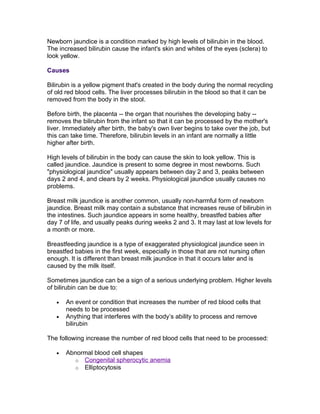
Newborn jaundice is a condition marked by high levels of bilirubin in the blood
- 1. Newborn jaundice is a condition marked by high levels of bilirubin in the blood. The increased bilirubin cause the infant's skin and whites of the eyes (sclera) to look yellow. Causes Bilirubin is a yellow pigment that's created in the body during the normal recycling of old red blood cells. The liver processes bilirubin in the blood so that it can be removed from the body in the stool. Before birth, the placenta -- the organ that nourishes the developing baby -- removes the bilirubin from the infant so that it can be processed by the mother's liver. Immediately after birth, the baby's own liver begins to take over the job, but this can take time. Therefore, bilirubin levels in an infant are normally a little higher after birth. High levels of bilirubin in the body can cause the skin to look yellow. This is called jaundice. Jaundice is present to some degree in most newborns. Such "physiological jaundice" usually appears between day 2 and 3, peaks between days 2 and 4, and clears by 2 weeks. Physiological jaundice usually causes no problems. Breast milk jaundice is another common, usually non-harmful form of newborn jaundice. Breast milk may contain a substance that increases reuse of bilirubin in the intestines. Such jaundice appears in some healthy, breastfed babies after day 7 of life, and usually peaks during weeks 2 and 3. It may last at low levels for a month or more. Breastfeeding jaundice is a type of exaggerated physiological jaundice seen in breastfed babies in the first week, especially in those that are not nursing often enough. It is different than breast milk jaundice in that it occurs later and is caused by the milk itself. Sometimes jaundice can be a sign of a serious underlying problem. Higher levels of bilirubin can be due to: • An event or condition that increases the number of red blood cells that needs to be processed • Anything that interferes with the body’s ability to process and remove bilirubin The following increase the number of red blood cells that need to be processed: • Abnormal blood cell shapes o Congenital spherocytic anemia o Elliptocytosis
- 2. • Blood type incompatibilities o ABO incompatibility (Mother has type O blood, baby does not) o Rh incompatibility (Mother is Rh negative, baby is not) • Cephalohematoma or other birth injury • Glucose-6-phosphate dehydrogenase deficiency • High levels of red blood cells (polycythemia) o More common in small for gestational age babies o More common in some twins • Infection • Prematurity • Pyruvate kinase deficiency • Transfusions The following interfere with the body's ability to process and remove bilirubin: • Alpha-1 antitrypsin deficiency • Biliary atresia • Certain medications • Congenital cytomegalovirus (CMV) infection • Congenital herpes • Congenital hypothyroidism • Congenital rubella • Congenital syphilis • Congenital toxoplasmosis • Crigler-Najjar syndrome • Cystic fibrosis • Gaucher's disease • Gilbert syndrome • Hypoxia • Infections (such as sepsis) • Lucey-Driscol syndrome • Neonatal hepatitis • Niemann-Pick disease • Prematurity In otherwise healthy babies born at 35 weeks gestation or greater, those most likely to eventually develop signs of newborn jaundice are those who have: • A brother or sister who needed phototherapy for jaundice • A high bilirubin level for their age, even if they are not yet jaundiced • Been exclusively breastfeed, especially if weight is excessive • Blood group incompatibility or other known red blood cell disease • Cephalohematoma or significant bruising • East Asian ancestry • Jaundice in the first 24 hours of life
- 3. Symptoms The main symptom is a yellow color of the skin. The yellow color is best seen right after gently pressing a finger onto the skin. The color sometimes begins on the face and then moves down to the chest, belly area, legs, and soles of the feet. Sometimes, infants with significant jaundice have extreme tiredness and poor feeding. Exams and Tests All newborns should be examined for jaundice at least every 8 to 12 hours for the first day of life. Any infant who appears jaundiced in the first 24 hours should have bilirubin levels measured immediately. This can be done with a skin or blood test. Babies should be assigned a risk for later developing jaundice before they leave the hospital. Babies are classified as low risk, low intermediate risk, high intermediate risk, or high risk. Many hospitals do this by routinely checking total bilirubin levels on all babies at about 24 hours of age. Further testing varies on the infant's specific situation and test results. For example, the possible cause of the jaundice should be sought for babies who require treatment or whose total bilirubin levels are rising more rapidly than expected. Tests that will likely be done include: • Complete blood count • Coomb's test • Measurement of levels of specific types of bilirubin • Reticulocyte count The level of albumin in the baby's blood may also be checked. Low albumin levels may increase the risk of damage from excessive jaundice. Treatment Treatment is usually not necessary. Keep the baby well-hydrated with breast milk or formula. Frequent feedings encourage frequent bowel movements, which helps remove bilirubin through the stools. (Bilirubin is what gives stool a brown color).
- 4. Sometimes special blue lights are used on infants whose levels are very high. This is called phototherapy. These lights work by helping to break down bilirubin in the skin. The infant is placed naked under artificial light in a protected isolette to maintain constant temperature. The eyes are protected from the light. The American Academy of Pediatrics recommends that breastfeeding be continued through phototherapy, if possible. In the most severe cases of jaundice, an exchange transfusion is required. In this procedure, the baby's blood is replaced with fresh blood. Treating severely jaundiced babies with intravenous immunoglobulin may also be very effective at reducing bilirubin levels. Outlook (Prognosis